What follows is the latest installment of the Year in Bedlam overview of the previous year’s best and worst movies, according to yours-truly. As always, the list only includes those movies released in the US either theatrically, on DVD or via pay per view, as well as a number of recommended DVD releases, and brief takes on some upcoming releases that look intriguing.
This year I’ll have to add an opening disclaimer for you millennials: be aware that there might be politically incorrect material herein! I certainly don’t go out of my way to be incendiary or controversial, but over the past couple of years people have been taking offense at my year-end listings. Offended not by my verdicts, it seems, but rather my perceived advocacy of controversial figures like Mel Gibson, Casey Affleck, Paul Verhoeven, etc.
It just so happens that this year I’ll be bringing up several more contested folk, including such non-Me Too/Time’s Up approved individuals as Kevin Spacey, James Franco and Matt Damon (whose two major ‘17 releases I disliked, although I imagine the fact that I reviewed them at all will have many of you clutching your pearls). For that matter, I’ve also included films by further enemies of PC culture like Alejandro Jodorowsky (who’s been declared anti-PC because he once claimed to have raped a woman while filming EL TOPO), Darren Aronofsky (because he was mean to Natalie Portman on the set of BLACK SWAN) and Scarlett Johansson (apparently “the face of white privilege”). Another potential shocker: many of my choices, my three favorite films of the year in fact, fail the popular Bechdel Test that measures feminine representation in movies.
Please understand: I’m not unsympathetic to the Me Too and Time’s Up movements, and can even understand the necessity of the Bechdel Test. What I don’t like is bullying, regardless of what part of the political spectrum from which it emerges. Misplaced outrage is another pet peeve of mine—I really hate to “mansplain,” but I contend that there are much better things to get outraged over than my opinions on movies.
So with that out of the way, here are my choices…
The Best
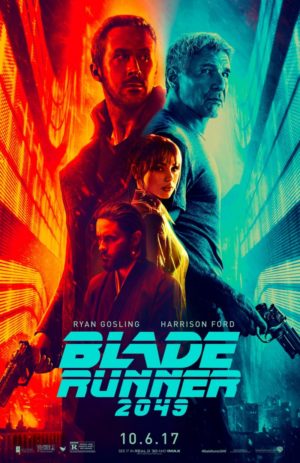 1. BLADE RUNNER 2049
1. BLADE RUNNER 2049
With this film director Denis Villeneuve (of SICARIO and the inexplicably overrated ARRIVAL) pulls off a pretty amazing feat, delivering a 35-years-after-the-fact BLADE RUNNER sequel that can nearly stand alongside the original film. Of course no post-BLADE RUNNER flick can or has been able to replicate its painstakingly achieved atmosphere of dystopian shock, nor its visual brilliance (and countless films HAVE tried), but Villeneuve comes remarkably close. As in the previous film we’ve presented with an exhaustively detailed future Los Angeles in which film noir tropes predominate, Atari has made an evident comeback, rain is ever-present and it’s difficult to tell replicant “skin jobs” from flesh-and-blood humans. Ryan Gosling plays one such skin job, one who’s ironically employed as a blade runner—i.e. a cop charged with “retiring” renegade replicants. While the overall narrative, involving a search by a corrupt replicant magnate (Jared Leto) and his robotic henchwoman (Sylvia Hoek) for the offspring of the previous film’s hero Rick Deckard (Harrison Ford), isn’t terribly invigorating, the screenplay (co-written by the original film’s main scripter Hampton Fancher) still manages to layer in a number of intriguing questions about the elusive nature of memory, humanity and reality itself. At nearly three hours the film is a bit overlong, but it’s easy to get lost—pleasantly so—in the superbly realized world created by Villeneuve and his talented collaborators, whose achievements represent the state of the art in science fiction cinema.
2. MOTHER!
Here we have a perfect example of a visionary and unclassifiable film that’s sure to be canonized by future film historians, who will almost certainly lament the fact that it was so misunderstood in its time. Unfortunately this is the present, wherein audiences, who are always claiming they want “something different,” have been staying away in droves (with the few who bothered seeing MOTHER! having decidedly less-than-positive reactions). In fairness, Paramount didn’t do a particularly great job marketing the film, making it look like a cookie-cutter Blumhouse horror fest. The casting of Jennifer Lawrence was another problem, as it seems J-Law has long since worn out her welcome with audiences (note the glee with which the news headlines trumpeted how IT’S Pennywise had “slayed” Lawrence at the box office). She’s actually quite good, providing a suitably captivating anchor to a film that hinges on disorientation. I won’t reveal what-all happens outside the basics: Jennifer plays the too-devoted wife of a renowned poet (Javier Bardem) who’s twice her age. They reside in the creepiest movie house this side of CRIMSON PEAK, wherein a host of bizarre occurrences take place that are best left for the viewer to experience directly. The film is further notable for writer-director Darren Aronofsky’s absolute mastery of tone and mood, which makes for an impressively orchestrated play of apprehension and unease that explodes in the final twenty minutes—which are, frankly, completely batshit. It’s all very European in feel (yet another likely reason the film didn’t click with American viewers), especially the work of Euro-auteurs like Roman Polanski and Andrzej Zulawski. Furthermore, I’d wager that the core relationship between Lawrence and Bardem is an accurate mirror of the much-publicized Lawrence-Aronofsky courtship, and adroitly foreshadowed how it ended up.
3. DUNKIRK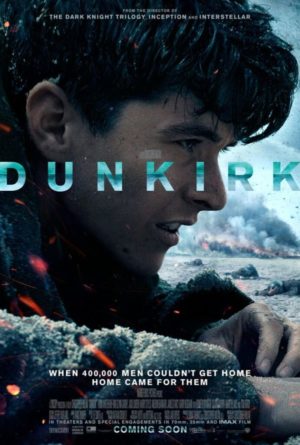
This may well be the masterpiece of Christopher Nolan, who’s created a WWII epic like no other. Focusing on the evacuation of British troops from Dunkirk by civilian boaters in the wake of a resounding military defeat, it’s a panoramic ensemble piece with a novelistic time-tripping structure. That structure has been criticized for making an already complicated account even more-so, but I say it works to the film’s advantage by forcefully conveying the event’s confusion and disorientation, and so enhancing the immersive vibe. I will complain about the sound design, which is so cacophonous it’s often difficult to make out the dialogue, and the repetitiveness of much of the action, particularly in the scenes involving Tom Hardy as a beleaguered fighter pilot (in which every shot looks the same). Offsetting those things is the sheer physical scale of the film, which is staggering, and the rawness of its visuals: the copious ocean scenes were clearly shot on a mighty choppy sea with what look like thousands of extras and non-CGI props, building up a cumulative power that’s undeniable.
4. A GHOST STORY
There’s never been a “horror” movie quite like this oddly placid and poetic rumination on themes of loss and disconnection, related in the form of a white sheet wearing ghost taking stock of reality before and after said ghost’s departure from the earthly plane. Casey Affleck plays this character, whose presence is first detected early on, when Affleck is still alive and living with his wife (Rooney Mara) in a seemingly haunted house—yes, the intimation I just made about Affleck encountering himself as a ghost was fully intentional, as that is indeed what occurs in a film whose many wonders and surprises I won’t spoil here. I will say that A GHOST STORY is very much an ART film, and arty it definitely is–often painfully so at times—but it also has a depth, intelligence and unwavering commitment to its singular vision that tend to mark out the greatest such films (i.e. those made by guys like Tarkovsky, Bergman and Herzog). I’ll also give praise to the sound design, which brilliantly juxtaposes silence and cacophony—and so is probably best experienced on a big screen.
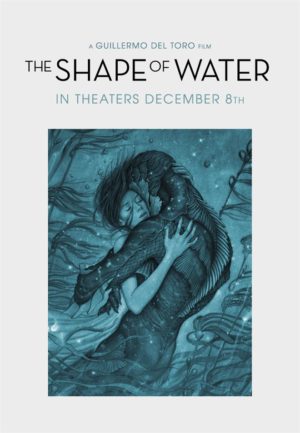 5. THE SHAPE OF WATER
5. THE SHAPE OF WATER
Guillermo del Toro’s latest is one of his best-ever films, a bold and horrific take on the BEAUTY AND THE BEAST theme that works on several levels. On the one hand it’s a pertinent depiction of America in the early 1960s, when Cadillacs were all the rage and gender roles were extremely rigidly defined, yet it’s also a potent fantasy romance. Lucy Hawkins plays a mute janitor at a research facility whose overseer, played by Michael Shannon, is examining an amphibious critter incarnated by Del Toro regular Doug Jones. After coming into direct contact with the creature Hawkins develops a perverse relationship with it, the carnal aspects of which Del Toro makes sure to elucidate. He also evinces a sure grasp of character (an element most modern genre films tend to neglect), as well as a wonderfully fecund visual sense. As for the performances, they’re uniformly flawless, from the main actors to Mr. Jones, who once again proves he can incarnate a non-human personage like no one else.
6. GET OUT
It’s taken some time, but it seems we may finally have the great black horror movie—meaning that, yes, GET OUT is better than SON OF INGAGI, GANJA AND HESS, BLACULA and TALES FROM THE HOOD. It was the directorial debut of Jordan Peele, of Key & Peele fame, who delivers an impressively gripping and assured piece of work that belies his inexperience. It helps that Peele’s script is enormously clever and imaginative, effectively dramatizing every African American person’s fears about white America in its story of a young black man (Daniel Kaluuya) visiting the affluent New England based parents (Bradley Whitford and Catherine Keener) of his white GF (Allison Williams). Kaluuya’s apprehensions increase upon finding that the family employs two oddly spacey and nonresponsive black servants, and the weird air only intensifies as Kaluuya is subjected to hypnosis by Keener and a horrific secret is revealed. It’s all tied up, unfortunately, in a pretty standard horror movie slash-a-thon that feels incompatible with the ingenuity of the rest of the film.
7. KUSO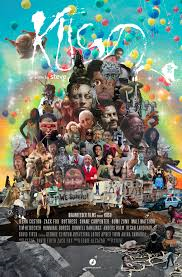
A freeform exercise in sub-Cronenbergian excess with a satiric thrust and overall fixation on bodily secretion. The feature filmmaking debut of hip hop artist Steve, a.k.a. Flying Lotus, KUSO is comprised of several interrelated shorts, each with its own cinematographer. The setting is Los Angeles in the wake of a catastrophic earthquake, with much of the population infected with a virus that causes, among other things, uncontrollable flatulence and nasty sores. In the surrounding countryside, meanwhile, strange creatures are birthed, among them a featureless mound with pulsating sphincter-like lips, inside of which a mutated human head appears. The film often feels like an extended music video, which it seems was precisely the effect Steve was after. He mixes animation with heavily stylized live action in a freeform manner that also incorporates CGI, music numbers, lengthy theatrical monologues and, most strikingly, digitally altered snippets from actual TV broadcasts (such as a seventies gameshow whose host and contestants are made to look deformed and pustule-faced). Tonally it’s closer to a Zucker Bros. parody than a proper horror film, yet has a streetwise aesthetic that contrasts mightily with the suburban milieus of most modern scare flicks (sample dialogue: “I grow on you, bitch, you don’t fuckin’ grow on me!”). Certainly no other horror film I’ve seen contains anything like the climactic scene in KUSO involving an ejaculating penis and a talking boil, an undoubted pinnacle of cinematic outrage.
8. PERSONAL SHOPPER
This in my view is the most successful of French writer-director Olivier Assayas’s many woman-centered reveries (which include IRMA VEP, DREAMLOVER, BOARDING GATE and THE CLOUDS OF SILAS MARIA). It helps, of course, that the film has a mighty compelling woman—Kristen Stewart(!)—in the lead, and a provocative supernaturally-tinged narrative. Stewart plays a young woman who works as a personal shopper for a famous fashion tycoon, meaning she does the woman’s shopping for her, buying oodles of expensive swag in various swanky boutiques. Stewart also attempts to channel the spirit of her deceased brother, with whom she made a bargain that should one of them die before the other that person would make contact from the afterlife; this would appear to inspire a series of suspicious texts from some unknown person that thoroughly unnerve the heroine. This is easily the most effective use of texting I’ve seen in a film, with Assayas thankfully ignoring the popular device of having the texts appear in the air beside a person’s face. Here the texts are presented properly, as close-ups of data on a smartphone, with Assayas building up a great deal of apprehension and suspense by doing so. But I’m sorry to say that the open-ended finale (which reportedly got roundly booed at Cannes) is unsatisfying, and severely curtails the film’s effectiveness. Again, though, Ms. Stewart is fully deserving of praise in a captivating depiction of loneliness, dissatisfaction and abject horror—plus she’s also damn sexy in the scenes in which she inevitably tries on her employer’s slutty outfits.
 9. WONDER WOMAN
9. WONDER WOMAN
It’s hard to believe, but this long-awaited live-action WONDER WOMAN movie is authentically good. The film’s behind-the-scenes travails have been well documented, yet somehow it turned out alright, mostly due to the enormously charismatic performance of Gal Gadot in the title role. Her presence, at once likeable and fierce, helps paper over some of the more annoying elements (overwrought CGI, gratuitous slo-mo, repetitive fight scenes) that were evidently bequeathed by producer Zach Snyder. Another standout element is the soulful and emotive arc, for which director Patty Jenkins deserves credit. No, Jenkins can’t quite overcome the superhero movie bullcrap that’s built into WONDER WOMAN’S DNA, but she does provide a pleasing and enjoyable spectacle.
10. THE DISASTER ARTIST
I’ve never entirely understood the adulation surrounding Tommy Wiseau’s THE ROOM, apparently the “best bad movie ever made,” but can’t deny that THE DISASTER ARTIST, an adaptation of Greg Sestro’s must-read book about the making of Wiseau’s opus, is really something else. Directed, surprisingly, by James Franco, who thus far hasn’t demonstrated much talent in the filmmaking arena (I guess he was bound to get it sooner or later), the film is funny and touching in its dramatization of the rocky yet affectionate relationship between the creepy and possibly insane Wiseau (played by Franco) and the aspiring actor Sestro (Franco’s bro Dave), from which THE ROOM was birthed. Franco does an uncanny imitation of Wiseau, a character so strange I doubt anyone would accept him in a purely fictional context, and also provides a number of strikingly accurate recreations of scenes from THE ROOM, with clips from that film and this one actually presented in split screen format near the end to show just how similar they are. My biggest complaint? That Franco was unable to pack in all the funny and bizarre revelations contained in Sestro’s book (such as Wiseau posting his home phone number on a billboard and then bitching about all the strange calls he receives).
11. 11/8/16
That’s a pretty self-explanatory title for a documentary about the eighth of November, 2016, a.k.a. Election Day. A sprawling portrait of America on that day, 11/8/16 is set in around a dozen states, with just as many directors. This explains the formless nature of much of the film, which suffers from awkward framing, underlit imagery and inaudible dialogue. The attempt, at least, is a valent one: to document the attitudes and reactions of Americans of all political persuasions on that fateful day. They include a coal miner, scared that his job will be taken away; a bickering couple, one of them an enthusiastic Trump supporter and the other a lukewarm one; a perky young woman attempting to convince her fellow students to vote for Clinton; a Muslim cab driver wanting to practice his religion without incident; and a congregation of illegal immigrants understandably apprehensive about their status should Trump win. The film’s best scenes are its later ones, in which the election results roll in and we see these people celebrate, succumb to despair or stubbornly cling to a desperate (and hopeless) optimism. I think the filmmakers would have been well advised to give more screen time to those voters who chose to sit out the election, as everyone here seems impossibly politically motivated, with the 47 percent of voters who abstained represented by a single individual: a Hawaii based homeless man who appears to be on hand to provide some exotic scenery rather than impart any wisdom.
12. ALL THE MONEY IN THE WORLD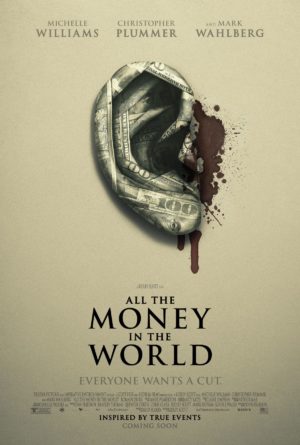
After THE LAST JEDI this fact-based drama was the most talked-about movie of 2017, and the one most directly affected by the end-of-the-year sexual harassment purge. I’d be interested in seeing the film’s original version, in which Kevin Spacey played J. Paul Getty, but there’s little-to-no chance of that happening. What we’re left with is the reshot version in which Christopher Plummer assumes the role—and quite ably, I might add—of Getty, the richest man in the world, alongside Michelle Williams as his daughter-in-law, whose teenage son was kidnapped in 1973 by a band of Italian scumbags who demanded three million dollars in ransom. Mark Wahlberg plays the Getty appointed security agent tasked with keeping Williams in line, precipitating a conflict between her and her infamously cheap stepfather. Screenwriter David Scarpa does a good job turning real-life events into a suspenseful drama (with some admitted fact-fudging), complimented by director Ridley Scott, who delivers a thrilling piece of cinema that nearly makes up for the awfulness of Scott’s other 2017 effort ALIEN COVENANT. I could, however, have done without the overdone dark-filtered visuals, which are pointless and distracting.
13. FIRST THEY KILLED MY FATHER
This is Angelina Jolie’s fourth try at directing a movie, and she’s finally gotten it right. FIRST THEY KILLED MY FATHER, about a young girl caught up in the mid-1970s Khmer Rouge takeover of Cambodia, is an impressive piece of work: tough-minded yet soulful, and related with an admirable simplicity. Loung Ung, who co-scripted, bases the film on her own childhood experience of being rounded up by Khmer Rouge soldiers and taken to a labor camp; there both her parents were killed and Loung wound up trained as a soldier. The problem is that Loung, as played by Sareum Srey Moch, is a near totally passive observer to the chaos around her, which puts Jolie in something of a bind as a director. Luckily Ms. Moch has an extremely expressive face, and Jolie’s staging of the Khmer Rouge’s outrages is quite strong. The heavy-handedness that marred a couple of Jolie’s earlier directorial efforts is mercifully absent here, as is the political sloganeering you might expect, with Loung’s wide-eyed POV being our sole conduit into this world-gone-mad. Jolie tried a similarly minimalistic approach in the failed UNBROKEN, but it actually works quite well here, in no small part due to the luminous cinematography of Anthony Dod Mantle, who perfectly captures the beauty and horror of Loung’s surroundings.
14. T2 TRAINSPOTTING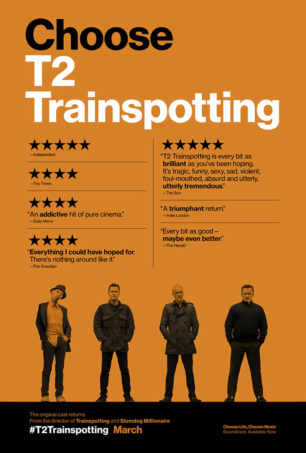
Another in the never-ending parade of un-asked-for decades-after-the-fact sequels, although T2, like BLADE RUNNER: 2049, actually turned out to be surprisingly engaging. No, it doesn’t match the original TRAINSPOTTING, which was a film of its time above all else. Many critics have complained that T2 lacks the “jolt” of its 1996 predecessor, but it is a convincing rendering of the fates of its principals. What we see here is a painfully true-to-life approximation of how the carefree twentysomething junkies of TRAINSPOTTING would fare as fortysomethings—as losers, specifically, attempting to juggle such problems as divorce, childrearing and employment, while attempting, often futilely, to stay clean and, needless to add, constantly reminiscing about the good old days. It all revolves around the money stolen in the first film by Renton (Ewan McGregor) from his pals, who include the psychotic Begbie (Robert Carlisle), the only slightly more upstanding Sick Boy (Johnny Lee Miller) and the suicidal Spud (Ewan Bremner). There’s plenty of the expected grungy humor and miscellaneous bad behavior so pivotal to the TRAINSPOTTING universe, but the climax, taken up by a lackluster action sequence, is a bit too pat, not to mention choppily edited and overlit.
15. BLUE VELVET REVISITED
This profoundly eccentric super-8mm montage, consisting of footage shot on the set of BLUE VELVET, makes for a good fit with eccentric David Lynch docos like DON’T LOOK AT ME and LYNCH. The footage was shot by German filmmaker Peter Braatz, who was present for the entirety of BLUE VELVET’S Wilmington, NC shoot. The charm of BLUE VELVET REVISITED is in its dreamy, meditative construction, comprised of audio interviews with Lynch and his cast members played over Braatz’s sound-free visuals. Another interesting aspect is the copious rehearsal footage of scenes familiar to viewers of BLUE VELVET, such as Isabelle Rossellini turning up naked on the front lawn of Kyle Machlachlan’s house and crooning the title tune; here, by contrast, we see Rossellini turn up on the lawn fully clothed and sing “Blue Velvet” without the curly haired wig she wears throughout the finished film, which makes for an interesting juxtaposition for BLUE VELVET fans. Everyone else, however, had probably best steer clear!
16. KINGSMEN: THE GOLDEN CIRCLE
This sequel to 2015’s KINGSMEN: THE SECRET SERVICE offers more of the same. This is to say that it’s in a category similar to GUARDIANS OF THE GALAXY VOL. 2, in that it replicates the look and attitude of its predecessor perfectly, even if it never quite succeeds in matching it. Taron Egerton returns as a young punk turned Kingsmen super-spy, who’s called into action after his headquarters get blown up by an evil drug magnate (Julianne Moore) who’s looking to bring the world to its knees by spiking her contraband with a deadly chemical agent. Egerton is inducted into a Jeff Bridges run spy organization called Statesmen, who’ve managed to bring Colin Firth, who was killed in the first KINGSMEN, back to life. There’s lots of flashy violence, including an elaborate single take fight sequence (a la the infamous church massacre of KINGSMEN 1) and a car chase set to Prince’s “Let’s Get Crazy” that starts the film out on an agreeably kinetic note (and also threatens to make it peak too early). At 141 minutes it’s too long, and the many outlandish inventions and contraptions (mechanical fighting dogs, etc.) are hopelessly implausible, even in the already skewed KINGSMEN universe. But the film is never less than completely entertaining, and Moore, as always, is a joy to watch.
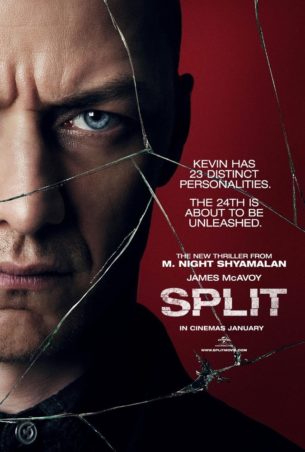 17. SPLIT
17. SPLIT
The latest entry in the M. Night Shyamalan-aissance was this depiction of a psychopath with multiple personality disorder. James McAvoy plays this character, who’s inhabited by 24 different personalities (although we only hear from five or six of them), including a supernaturally endowed “beast.” He kidnaps three teenage girls (the striking Anya Taylor-Joy, of THE WITCH, among them) whom he holds hostage in his compound, where his various personalities act as jailer, janitor and confidante. Filmmaking-wise SPLIT is impressive, and notably restrained in its depictions of gore and sexuality (which of course hasn’t stopped some dweebs from bitching about how “exploitive” the film allegedly is). Alas, it doesn’t go anywhere especially interesting, and concludes with a downright annoying reference to one of Shyamalan’s previous, much older films—a reference that will doubtless sail clear over the heads of SPLIT’S youthful target audience.
18. THE FOUNDER
This well-made prestige pic focuses on Ray Croc, who back in the 1950s was instrumental in making McDonald’s the powerhouse franchise it became. I can recall reading Croc’s autobiography GRINDING IT OUT years ago, and being troubled at how he disparaged the McDonald brothers, the true founders and architects of McDonald’s (with Croc repeatedly chastising them in the book for not thinking big enough—i.e. not thinking like him). This movie, thankfully, takes into account the McDonalds’ plight, showing that Croc, played by Michael Keaton, was not the pure-hearted “founder” of McDonald’s that he liked to proclaim himself. Much of the film’s interest, in fact, is in how it shifts gears, initially presenting Croc as a heroic innovator only to unveil his true, duplicitous nature in the third act. Keaton is quite strong as Croc, and the film extremely well directed by John Lee Hancock, who displays a spot-on eye for period detail.
19. LOGAN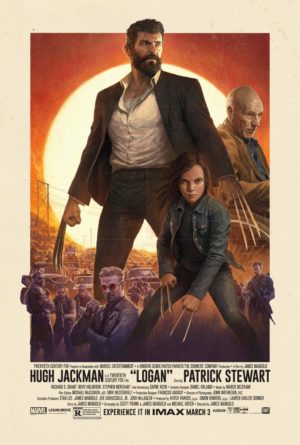
The new R-rated comic book aesthetic is given a bone-crunching workout in this latest installment of the X-MEN series, with Hugh Jackman headlining as the brooding and downcast Wolverine, a.k.a. Logan. Unlike most of the other X-MEN flicks, this one really shows the violence that Logan is capable of in a succession of extremely brutal set-pieces in which he stabs, slashes and impales what look like hundreds of bad guys. Patrick Stewart likewise returns as Professor X, who suffers debilitating seizures that have the effect of paralyzing everyone around him, as does Logan’s evil alter ego, the only really worthy opponent he faces. Jackman, as always, is quite strong as Logan, and director James Mangold works hard not to tame or sugar-coat his exploits in the slightest. Even the young girl who latches onto Logan (Dafne Keen) is portrayed as tough and uniquely ruthless (and, it turns out, with good reason).
20. BABY DRIVER
Another example of filmdom’s apparently never-ending fascination with getaway drivers (following THE DRIVER, THE TRANSPORTER, DRIVE, etc.). The driver here is a young man (Ansel Elgort) known as baby, who never goes anywhere without his iPod, and times his driving to the rock tunes he continually listens to. His employer is a sociopathic criminal mastermind, played by Kevin Spacey in what appears certain to be his last film role for some time. Also appearing are Jon Bernthal, Jon Hamm, Lily James, Jamie Foxx, Flea, Paul Williams and many other familiar faces, with the true star being writer-director Edgar Wright, who provides an action-intensive spectacle that’s highly shallow and derivative (as he did a decade ago in HOT FUZZ, Wright includes a number of “tributes” to Kathryn Bigelow’s POINT BREAK) but diverting nonetheless. This is to say that the many car chases are extremely well put together, with an eye for kineticism and a superbly utilized classic rock soundtrack.
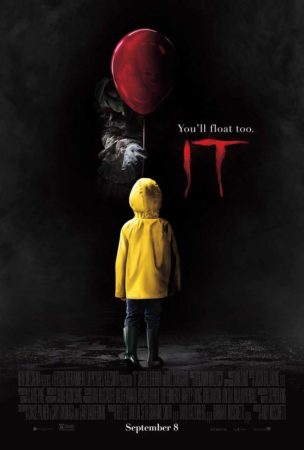 21. IT
21. IT
Make no mistake: in the lexicon of Stephen King adaptations this film is above-average (especially in the company of THE DARK TOWER and GERALD’S GAME, 2017’s other King-based flicks), but it’s far from the genre classic so many have proclaimed it. The film works primarily due to the lip-smacking performance of Bill Skarsgaard as the shape-shifting clown Pennywise, whose presence has been beefed considerably up from the book (in which he transformed into various creatures, including the Wolf Man and Rodan). In the late 1980s (a time frame moved up thirty years from that of the book) Pennywise is killing children in the sleepy town of Derry, ME, which inspires seven youngsters to band together and take him on. Having read the book twice, I’m not entirely okay with the changes wreaked upon the text by director Andy Muschietti and screenwriters Chase Palmer, Cary Fukunaga and Gary Dauberman; certainly King’s ending, involving a big spider and an underage sex orgy, could have stood to be revamped, but I’m not sure the new coda, involving lots of floating corpses and a kiss of life, is much of an improvement. Further annoyance is provided by the overdone soundtrack, filled with noisy aural effects that sound as if they were filched from the final bars of “A Day in The Life.” But Muschietti and co. understand what makes the material memorable: the seven protagonists, who unlike so much else in this film are kept very close to their literary counterparts (in particular Sophia Lillis as Beverly, who appears to have been conjured directly from King’s descriptions), and for whom it’s impossible not to root.
22. DETROIT
A good, if overlong and uneven, depiction of the Detroit riots of 1967, during which three black men were killed by policemen in the notorious Algiers Motel incident. Director Kathryn Bigelow provides an appropriately hard-hitting and unforgiving depiction of the incident, with Will Poulter as the racist cop who instigated the whole thing and John Boyega as a none-too-heroic security guard who gets caught up in the mess—and is made to pay dearly for his timidity. There are no heroes in this film, nor any happy endings, which probably explains why it flopped so severely. Bigelow utilizes ultra-mobile handheld camerawork, which has become something of a cliché in reality-based cinema but works nonetheless, while the period detail is generally quite strong and authentic-feeling—although those things are of no help in the final third, which turns into a dull courtroom drama that brings the proceedings to a screeching halt.
23. THE KILLING OF A SACRED DEER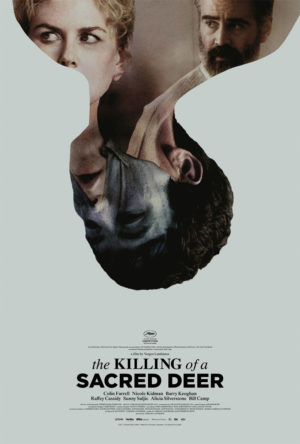
The early scenes of this film look like someone doing a bad imitation of a Yorgos Lanthimos movie, with that someone being Yorgos Lanthimos himself. Note the overdone visuals, seen more often than not through absurdly obtuse vantage points (such as looking down from the ceiling of a tall building), and highly affected atmosphere of deadpan discomfort. Yet things improve as the film advances, and build to a genuinely shocking and horrific climax. The story involves a surgeon (Colin Farrell) who befriends the teenage son (Barry Keoghan) of a patient who died in surgery. It seems that, in this film’s mythologically informed universe, Farrell has to sacrifice one of his two children or else they and his wife (Nicole Kidman) will all die—a process set in motion when Farrell’s kids fall prey to a mysterious illness. The actors do their best to bring some semblance of gravitas to this terminally loopy premise (and don’t always succeed), resulting in a conditional success of a movie, i.e. one that doesn’t quite work but has a sizable impact nonetheless.
24. WAR FOR THE PLANET OF THE APES
The latest installment in what is certainly among the most subversive Hollywood franchises of all time once again takes place on the “planet of the apes”—i.e. Earth—where intelligent apes, led by the Andy Serkis essayed Caesar, rule. Serkis’s soulful and empathetic performance is, as in the previous installments, the highlight of the film, accentuated by flawless CGI and the fact that he’s the hero—with the militaristic human characters, led by an evil Woody Harrelson, presented as the bad guys. As directed by Matt Reeves, the proceedings are admittedly never as compelling as they could be (this is one of those movies that appears to end several times before it actually does), and the copious explosions and shoot-outs are pretty average in the Hollywood blockbuster lexicon, but Serkis’ work more than makes up for the film’s shortcomings.
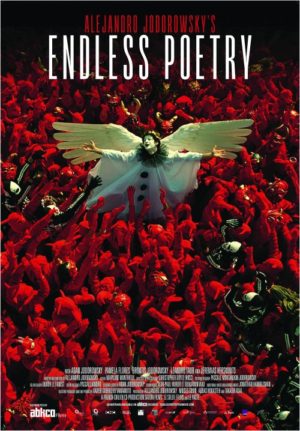 25. ENDLESS POETRY (POESIA SIN FIN)
25. ENDLESS POETRY (POESIA SIN FIN)
A new film by Alejandro Jodorowsky! That fact alone renders the crowd-funded ENDLESS POETRY a must-see, even though it’s far from Jodorowsky’s best work. A sequel to the maestro’s previous film THE DANCE OF REALITY, it dramatizes Jodorowsky’s poetry-fused adolescence in his native Chile. There we see Jodorowsky (played by the filmmaker’s son Adan) doing things like getting it on with a horny dwarf woman, attempting to walk in a straight line for as long as he can, getting called a “faggot” by his father (played by Jod’s other son Brontis), leading a parade of skeleton dancers, and eventually decamping for Paris with the aim of becoming the “savior of surrealism.” At over two hours the film is notably overlong, and self-indulgent even by Jodorowsky standards. But the quirkiness and imaginative verve on display are undeniable, as is the multi-hued brilliance of the cinematography by the great Christopher Doyle. There are also some truly extraordinary moments, such as Jodorowsky’s simultaneous rejection of and reconciliation with his long-dead father, depicted via the man himself joining his fictional alter-ego, a wonderfully crazed bit of inspiration that I doubt too many other filmmakers would attempt, much less pull off.
26. I, TONYA
In which we learn about the infamous Tonya Harding, the disgraced figure skater behind (or so it’s been alleged) the 1994 assault on her rival Nancy Kerrigan. Director Craig Gillespie relates the facts of Tonya’s life in an account that veers wildly between tragedy and smart-assed comedy, and never quite succeeds in finding a balance between the two. One thing that is for certain is the evident fascination Gillespie has with his subject’s white trash background, which is played to the hilt—meaning there’s a great deal of shouting, hitting and assorted trash talk. In fact, based on what we’re shown here it was this background more than anything else that did in Tonya Harding’s skating career, as she was unable to escape it in either her surroundings or behavior. Yet ultimately this is an actor’s showcase, with the film’s main selling point being the performance of Margot Robbie in the title role. Robbie’s acting is indeed quite strong, and kudos are also due to Allison Janney as Tonya’s borderline evil mother.
27. LUNA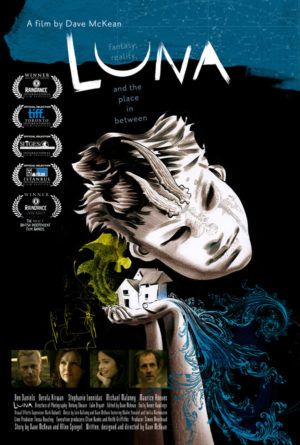
The latest feature from comic book artist turned sometime filmmaker Dave McKean. His work as a director has thus far failed to match his brilliance as an artist (in volumes like BATMAN: ARKHAM ASYLUM and CAGES), although with LUNA McKean shows he’s at least getting close to bridging the gap. It’s a definite improvement over McKean’s previous feature MIRRORMASK, even if it lacks the touch of his frequent writing collaborator, the skilled Neil Gaiman. LUNA’S McKean penned script, in fact, is its weak link, filled with clunky, obvious dialogue and a worldview that’s about on the level of the children’s fantasies its protagonist (Michael Maloney) writes. This guy, who lives with his much younger girlfriend (Stephanie Leonidas) in a forbidding seaside house, is visited by a friend (Ben Daniels) and his wife (Dervla Kirwan), who are consumed with grief over the death of their baby. McKean himself reportedly dealt with a situation very similar to that of Maloney’s character, so I’ll have to assume that LUNA is at least partially autobiographical. It certainly has a more humanistic angle than MIRRORMASK, yet the design-heavy fantasy aesthetic of that film is carried over in a succession of hallucinatory animated sequences that dramatize the characters’ disturbed psyches—and occasionally carry over into the “real” world. That unique reality-fantasy mixture is what gives this film its charge, along with the above-average performances. It’s just too bad the script doesn’t give those talented performers more to work with.
28. JIM & ANDY: THE GREAT BEYOND
This Netflix doco, from the veteran documentarian Chris Smith, relates what happened when Jim Carrey signed on to play Andy Kaufman in the 1999 flick MAN IN THE MOON. According to what we’re shown here, courtesy of video footage taken during the MAN ON THE MOON shoot and retrospective interviews with a heavily bearded (and uncharacteristically subdued) Carrey, the man took the concept of method acting to an extreme Robert DeNiro and Daniel Day Lewis have probably never approached. If we’re to believe Carrey’s claims, he was literally possessed by the spirit of the long deceased Kaufman, and the latter’s even more obnoxious alter-ego Tony Clifton. This leads to much annoyance on the parts of MAN IN THE MOON’S crewmembers, particularly director Milos Forman, who constantly begs “Andy” to stifle his antics, and pro wrestler Jerry Lawler, who Carrey-as-Kaufman annoys incessantly even when the cameras are turned off—and who claims Carrey was far more obnoxious than the real Andy Kaufman ever was. This suggests that Carrey’s Kaufman channeling may not have been as authentic as he claims, but then the majority of JIM & ANDY functions as, essentially, a Jim Carey biopic that covers his impoverished childhood and early stand-up years in far more depth than it does the subject at hand.
Recommended DVD Releases
THE APPLE
One of the most noteworthy releases by the notorious Cannon Group was this must-be-seen-to-be-disbelieved disco fueled futuristic spectacle, now contained in an extras-packed Blu ray.
BAND OF THE HAND
Fun eighties action movie delirium that never got much attention of any sort. Maybe now it will!
BARTON FINK
One of the Coen brothers’ greatest flicks is now available in a special edition Blu ray, in place the vanilla DVD version with which we previously had to make do.
DEATH LAID AN EGG
There aren’t many extra features of note on this Cult Epics DVD, but I’m still glad to see this endearingly nutzoid 1968 giallo finally get an authorized home video release in the US.
ELECTION
This unforgettably sharp and savage nineties comedy, a longtime favorite of mine, has been Criterionized in a release that’s everything I could have hoped for.
FUNERAL PARADE OF ROSES
An authorized US release (the first) of Toshio Matsumoto’s unfettered 1969 masterpiece, one of the most delirious and exhilarating films of its era.
INTO THE NIGHT
I’ve always liked this eighties comedy-actioner from John Landis, which up until 2017 was somewhat hard to find—a big thanks to Shout! Factory for remedying that situation!
THE LONG RIDERS
Walter Hill’s shamefully underrated 1980 western finally gets the home video release it deserves, in the form of a jam packed 2-disc Blu ray from Kino.
OBSESSIONS
This late 1960s Dutch psychothriller is not an especially great movie, but it is an interesting one that was co-scripted by a young Martin Scorsese (with assistance, it’s been rumored, from an uncredited Paul Verhoeven).
OTHELLO
This was one of Orson Welles’s greatest films, and it’s now available in decked-out Criterion format. Quite simply: you need one!
A QUIET PLACE IN THE COUNTRY
Prior to 2017 the only way you could see this wonderfully twisted late-1960s Italian chiller was in DVD-R format from MGM. It’s great to see it finally get a proper home video release, courtesy, once again, of Shout! Factory.
SPIDER
A visual marvel of hallucinatory horror from pre-Glasnost Russia, released in a new thrice-welcome Blu ray by Mondo Macabro.
STREETS OF FIRE
A true eighties classic, and one of the most interesting films directed by Walter Hill, was given the deluxe Blu ray treatment in 2017, and I say it’s about goddamn time!
SWEPT AWAY
This was a surprise Blu-ray release considering that SWEPT AWAY, arguably the masterpiece of director Lina Wertmuller, is one of the most politically incorrect films ever made. I’m certainly not complaining, though!
THEY SHOOT HORSES, DON’T THEY?
One of the toughest, most grueling American films of the 1960s, and indeed of all time, was this Sydney Pollack directed adaptation of Horace McCoy’s equally relentless novel, now available in its first-ever special edition Blu-ray.
THREE O’CLOCK HIGH
Another essential Shout! Factory release, THREE O’CLOCK HIGH was one of the most stylish and underrated teen comedies to appear in the eighties, and Shout!’s extras-packed Blu ray does it justice.
TRESSPASS
Another Walter Hill classic that received its long-awaited home video apotheosis in 2017 was this outrageous early nineties depiction of racial strife, co-scripted by Robert Zemeckis.
TWIN PEAKS: FIRE WALK WITH ME
David Lynch’s most contentious and underrated film gets Criterionized, complete with retrospective interviews and 90 minutes’ worth of deleted scenes.
WILLARD
It’s taken an unconscionably long time, but a DVD/Blu ray release of this killer rat classic from the seventies is FINALLY available (as is its sequel BEN)!
WOLF GUY
Another long awaited DVD/Blu release, this one a Sonny Chiba headlined chop-socky/werewolf exploiter that until just a few years ago was considered lost.
The Worst
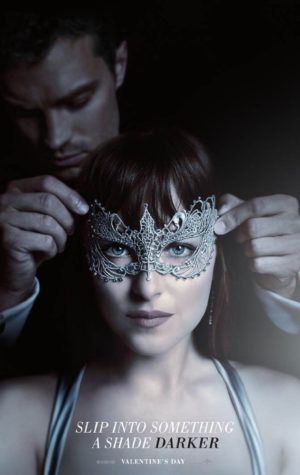 1. FIFTY SHADES DARKER
1. FIFTY SHADES DARKER
There’s simply no way this film couldn’t suck. The sequel to FIFTY SHADES OF GREY, it once again features Dakota Johnson as Anastasia Steele, who dumped her rich B&D enthusiast boyfriend Christian Grey (Jamie Dornan) at the end of the previous film. Here they get back together, only to have Anastasia’s jealous boss and a couple evil folks from Christian’s past turn up to sabotage things. If FIFTY SHADES OF GREY can be said to have had any redeeming quality it was the performance of Ms. Johnson, who can play dorky and sexy with equal aplomb. Here she ditches the former quality and plays up the latter, appearing in a number of agreeably slutty designer outfits. I’m certainly not complaining about that, although I will bitch about the uniformly unerotic “erotica” (even the already-infamous elevator fingering sequence is shockingly limp) and the lack of any real drama. Then again, I was probably wrong to expect that much from a movie that never aspired to more than the late night cable TV-worthy spank fest it is.
2. ROUGH NIGHT
The latest attempt at BRIDESMAIDS-inspired female raunch was this unforgivably lackluster Scarlett Johansson vehicle. She stars as one of a group of gals, whose ranks include a faux-Australian accent sporting Kate McKinnon and Jillian Bell in the Melissa McCarthy/Rebel Wilson role, who hold a rowdy bachelorette party in a swank beach house. There a male stripper is hired but gets killed, leaving the gals in a WEEKEND AT BERNIE’S type situation. That comparison, FYI, is far too generous, as this witless movie isn’t nearly as memorable as WEEKEND AT BERNIE’S. Part of the problem is with ScarJo herself, who is simply not much of a comedienne. But then, the filmmakers don’t give her much to work with, and insist on twisting the material into a standard rom-com resolution—which is to say a happy one that completely ignores the moral and legal implications of the protagonists’ actions (spoiler alert: the dead stripper turns out to be a bad guy, and so, the filmmakers imply, it’s okay that he gets killed).
3. THE LOST CITY OF Z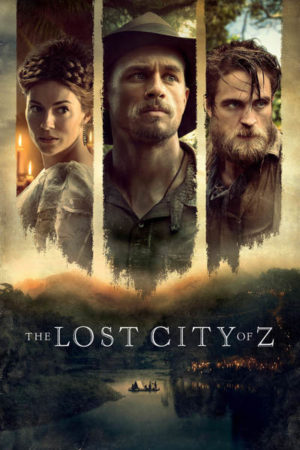
A(nother) disappointment from director James Gray, a disappointment rendered all the more acute because the material he’s working with was quite promising. It could potentially have made for a great Werner Herzog movie, telling the story of the British explorer Percival Fawcett, who in the early 20th Century led multiple expeditions into the Amazon to discover a lost civilization he believed was located therein. Gray’s dramatization of Fawcett’s exploits is shockingly dull and disjointed, with more time spent in England than the jungle. Even the Amazon-set sequences are uninteresting, having been lensed and edited like a TV movie—although a TV movie, I’m certainly, would have been more entertaining than what Gray provides (and definitely more focused). In the lead role Charlie Hunnam is hopelessly distant and hard to relate to, much like the film overall.
4. THE GREAT WALL
Someday this flick, an expensive Chinese-American co-production, may be viewed as some kind of bad movie classic. For now, though, it’s a thoroughly ridiculous concoction that if you ask me should never have advanced beyond the conception stage. It garnered a fair amount of controversy due to its depiction of the very Caucasian Matt Damon leading a largely Asian cast, but Damon’s presence is just one of an endless succession of implausibilities. The setting is feudal China, where color-coded armies are stationed along a section of the Great Wall in order to hold off a gaggle of lizard critters from outer space. The director was the formerly great Zhang Yimou (of classics like RAISE THE RED LANTERN and HERO), who attempts to replicate the styles of Hollyweird hitmeisters like Michael Bay and Zack Snyder in a succession of slow motion heavy action sequences. Yet from start to dispiriting finish the proceedings look like exactly what they are: a pathetic attempt at commercial moviemaking by a filmmaker with little aptitude for, or evident interest in, such fare. Then there’s the CGI, which is ever-present; in that respect, at least, Yimou and his collaborators are definitely in synch with their Hollywood counterparts, who all insist on believing that CGI is still cool. It isn’t!
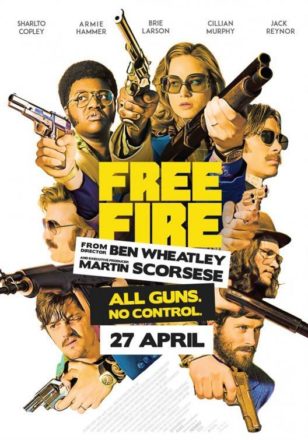 5. FREE FIRE
5. FREE FIRE
Silly me: I thought the Tarantino wannabe movie craze had long since run its course. FREE FIRE is the latest film from the UK’s talented Ben Wheatley, who in true Tarantino fashion crafts a highly seventies-centric black humored kill-fest in which a bunch of wise-cracking mobsters find themselves stuck in an endless shoot-out in a warehouse. The film’s problems begin early on in the character development stage: quite simply, none of those characters, despite being played by skilled actors like Sharlto Copley, Brie Larson and Cillian Murphy, are very interesting. Nor the shoot-out, which is staged in a shockingly pedestrian manner; people are constantly getting shot in the legs or shoulders (because the movie would be over in five minutes if they weren’t), and of course finding ample time to make dumb jokes. The conclusion isn’t much, either, offering little in the way of justification of or payoff for what we’ve just sat through, and providing confirmation of the adage that Quentin Tarantino movies are best made by Quentin Tarantino.
6. ALIEN CONVENANT
To those who say I’m too hard on CGI, I submit ALIEN COVENANT as exhibit A in my defense. It’s yet another ALIEN sequel, albeit one that’s rendered noteworthy due to the fact that it was helmed by the original film’s director Ridley Scott. Not that you’d be able to tell, as this new ALIEN is about equivalent to ALIEN 3 or ALIEN VS. PREDATOR in quality—which is too say, not very good at all. The problem, as I stated upfront, is with the CGI overload, which is utilized here in place of the care and imagination that went into the original ALIEN. Once again we have a motley band of cosmonauts, played by actors like Billy Crudup, Catherine Waterson and Amy Seimetz, landing on a planet where they get ambushed by aliens. Many intriguing concepts are introduced, such as a group of humanoid nomads wiped out in mass and an Ebola-like contagion that’s even more potentially dangerous than the aliens (Scott, FYI, was once slated to direct OUTBREAK), but the point here, as in all the ALIEN flicks, is to show people being chased around and killed by the slimy critters. We do get plenty of chasing and killing in a climax that tries to outdo James Cameron’s ALIENS in intensity, but the CGI-addled proceedings fall far short of Cameron’s achievement. Even in the so-bad-it’s-good category (into which an altogether ridiculous shower love scene interrupted by an unwanted alien tentacle could potentially fit) ALIEN CONVENANT falls short.
7. NOCTURAMA
A film that sounds much better than it plays, NOCTURAMA is about a group of severely disillusioned Parisian twentysomethings who set off bombs throughout Paris and then hole up in a department store for the night, where they inevitably fall prey to paranoia and infighting. The film was shot prior to the Paris attacks of November 2015, and so has a much different resonance than director Bertrand Bonello intended; NOCTURAMA’S problems, however, go far beyond that unfortunate fact. As with many modern European filmmakers, Bonello appears to have mistaken uneventfulness and shots held too long for cinematic realism—or perhaps he was attempting something along the lines of the type of deadpan horror practiced by filmmakers like Michael Haneke and Yorgos Lanthimos. Whatever Bonello was up to, it doesn’t seem to have worked, as NOCTURAMA is uniformly uninvolving and shockingly dull, despite solid staging and committed performances.
8. THE BAD BATCH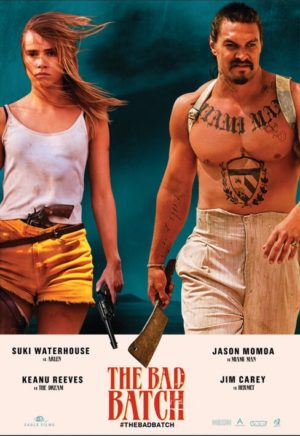
It’s hard to say precisely what went wrong here. The second feature by A GIRL WALKS HOME ALONE AT NIGHT’S gifted Ana Lily Amirpour, THE BAD BATCH is set in a post-apocalyptic desert wasteland packed with lawless cannibals. There a young woman (Suki Waterhouse) loses a leg and an arm to the flesh eaters but still manages to make her way through this dystopia, where she meets several eccentric folk, among them a dangerous cult leader (Keanu Reeves) and a young girl (Jayda Fink) who arouses the heroine’s maternal instincts. Also making appearances are Giovanni Ribisi and an unrecognizable Jim Carrey in a film that, with its stylish helming and bleakly humorous tone, should have been the cult sensation of the decade. THE BAD BATCH, however, is curiously lifeless. The problem may be with the sparseness of the settings (which appear to be the result of an overly scant budget rather than nuclear or biological devastation), or maybe the glacial pacing that has the effect of calling unwelcome attention to the uneventfulness of the narrative, or perhaps Waterhouse’s utterly unconvincing Texas accent. Whatever the reason, the film just doesn’t work.
9. RINGS
This latest installment in the RING franchise was proclaimed a “Thrilling Return to Franchise Roots.” In truth it’s a cookie-cutter Hollyweird horror fest bearing more in common with the FINAL DESTINATION flicks than ‘02’s THE RING (or its Japanese antecedents), with young folk watching the accursed Ring video either on a vintage VCR or computers, and dying a week later, more often than not through elaborate accidents. The one commendable element is the dark-hued David Fincher-esque visuals created by director F. Javier Gutierrez and cinematographer Sharone Meir, but it’s not enough to elevate a resolutely monotonous and uninspired product.
 10. UNFORGETTABLE
10. UNFORGETTABLE
A throwback to the early nineties, when psycho-bitch-from-Hell movies were all the rage. Had it appeared in 1992, in fact, UNFORGETTABLE, the directorial debut of veteran producer Denise Di Novi, might have made for an acceptable time-passer. It features Katherine Heigl in the psycho bitch role, who is, among other things, upset about losing custody of her daughter to her ex-husband’s new wife Rosario Dawson—and, as we know from THE HAND THAT ROCKS THE CRADLE and MOTHER’S DAY, misplaced maternal instincts are a surefire signifier of homicidal tendencies. Heigl is also a compulsive masturbator, which, as we learned in SINGLE WHITE FEMALE and THE TEMP, is an even more virulent red flag, leading to sexual aggression that, as was made clear in BASIC INSTINCT and DISCLOSURE, is certain to turn out badly for everyone involved. As in all the above-mentioned films the whole thing is hopelessly schlocky and implausible, and, with its social media-saturated narrative (the one area in which UNFORGETTABLE feels modern), doesn’t even work as nostalgia.
11. WONDERSTRUCK
I’m tempted to give this film points for effort, as it’s unique and unprecedented, and has a tone and style all its own. Those are definite pluses in my eyes, yet WONDERSTRUCK fails to satisfy. The overriding problem, it seems, is one that has affected quite a few of the films of director Todd Haynes: an inflated ambition that’s ill served by the non-budget with which Haynes was saddled. The setting is New York City in the 1920s and ‘70s, via two separate but intertwined narratives; the first involves a deaf girl (Millicent Simmonds) in search of her long-lost father, and the second a Midwestern boy (Oakes Fegley) who after losing his hearing in a lightning strike heads to NYC in search of his own father, with both narratives culminating in the Museum of Natural History. What renders the film most interesting is the stylization of its dueling time periods, with the first done in the style of a silent movie and the second in that of a grindhouse musical—or at least, that was the attempt. Despite luminous cinematography by Ed Lachman, both sections feel labored and unconvincing (a Guy Maddin film this isn’t), and unforgivably sluggish in terms of pacing and storytelling.
12. THE BEGUILED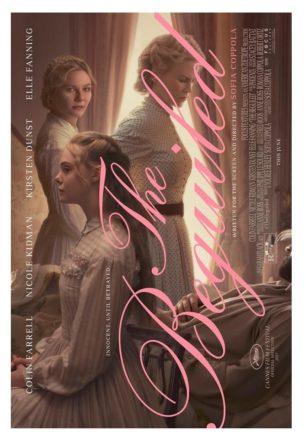
The latest in the unnecessary remake craze comes from a surprising source: Sofia Coppola, who for some reason thought it would be a good idea to reboot Don Siegel’s classic Clint Eastwood starrer THE BEGUILED. As in the original, this BEGUILED is set in a Southern girls’ boarding school during the Civil War; there a wounded Yankee soldier (Colin Farrell) appears one day and upends the gals’ ordered existence. The perverse sexual angle that drove the original is still present, but quite muted, while a pivotal character (the black maid) has been jettisoned entirely, and the infamous leg amputation occurs off-screen—as does the climactic turtle killing that seals the soldier’s fate. Regarding that fate, it’s not hard to foresee, even if you don’t already know the material as well as I do. About the only thing this update has in its favor, aside from some memorable performances (specifically Nicole Kidman as the headmistresses and Elle Fanning as one of her randier students), is its rich and atmospheric portrayal of 1800s South, which only calls attention to how shallow the film is in all other aspects.
13. DEEP IN THE WOOD (IL FONDO AL BOSCO)
Another almost movie, this one an Italian thriller about a kid (Teo Achille Caprio) who inexplicably disappears during the annual “Krampus Night” festival in October. The kid reappears, yet is far meaner than he was before—among other sins, he kills the family dog. The kid’s father (Filippo Nigro) thinks he’s just severely traumatized, but his mother (Camilla Filippi) doesn’t believe he’s her son. Which of them is right? For a great deal of the running time director Stefano Lodovichi manages to keep us guessing about the kid’s true identity and what may have happened to him while he was away, and does so in surprisingly elegant and graceful fashion. Alas, it all goes to pieces in the end, wherein Lodovichi attempts to lay an M. Night Shyamalan-esque twist on us that does nothing to clear things up, leading to a thoroughly unsatisfying fade-out.
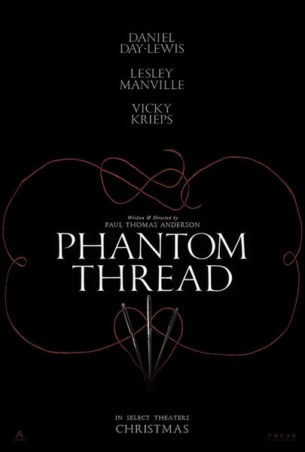 14. PHANTOM THREAD
14. PHANTOM THREAD
The combination of writer-director Paul Thomas Anderson and star Daniel Day Lewis is an irresistible one, and the likely reason so many critics have gone so easy on this film. In truth, though, it’s a hodgepodge, and one of Anderson’s few outright misfires. The film’s problems start with the fact that Anderson, unable to get the cinematographer he wanted, acted as his own director of photography, which unless you happen to be Stanley Kubrick is usually always a mistake. That’s particularly true here, given that the film is extremely color and design heavy, and dependent on visual seduction that Anderson’s grainy and inconsistent lighting fails to achieve. There’s also the problem of the script, which in printed form runs just 76 pages yet was conflated to a 130 minute movie. This means there’s a surfeit of evident bloat, and a narrative, involving D.D. Lewis as a 1950s-era British dressmaker who becomes romantically besotted with a quirky young woman (Vicky Krieps), that’s hopelessly thin.
15. HOSTILES
An example of the new politically correct Hollywood western, in which white cowboys and Native Americans get along, women are respected and racism is nonexistent. Those aren’t inherently bad things, but they do undercut the sense of realism writer-director Scott Cooper was trying to impart. Christian Bale stars as an army captain escorting some Cheyenne convicts across the country due to the fact that their leader (Wes Studi) has a terminal illness and wants to die on his homeland. Along the way they run into Rosamund Pike as a deranged widow whose family is massacred by bad Cheyennes in the opening scene. That scene is powerfully brutal and impacting, so much so that the rest of this brooding, scenery-heavy film fails to live up to it. Performance-wise Bale is strong as always (although I could have done without his mumbled dialogue), as is Pike, while Studi is even more stoic and imperturbable than usual.
16. THE POST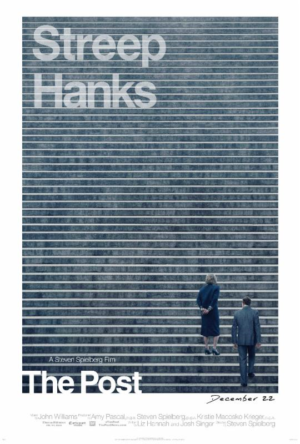
A message movie from Steven Spielberg that was made in great haste–Spielberg apparently found the material of such burning importance he decided he had to get it out ASAP—and it shows. Note the extremely stagey and inauthentic depiction of 1970s-era NYC, which has all the hard-hitting realism of an episode of TAXI (the choreography of the extras in the many crowd scenes is especially substandard). We’re not supposed to care about such things, of course, as the film’s overriding message is so urgent—and indeed, it is a pertinent message about the importance of journalistic integrity in the face of resistance by the President of the United States. The former camp is represented by Meryl Streep as the publisher of the Washington Post, and Tom Hanks as an editor attempting to publish evidence of the Nixon Administration’s cover-ups about the Vietnam War, and getting resistance from the top—although Spielberg’s true concern is clearly with our current administration and its overtly fascistic attempts at controlling the media. Laudable, certainly, and if messages were enough to make for quality cinema than THE POST would be a classic, but they aren’t and it isn’t.
17. MOLLY’S GAME
This film is compelling for the most part, and boasts a strong central performance by Jessica Chastain—and an equally strong supporting turn by Idris Elba—but it’s unsatisfying. Writer-director Aaron Sorkin appears to have been attempting something akin to a female-centric WOLF OF WALL STREET but was stymied by, among other things, political correctness. Chastain plays Molly Bloom, who after being sidelined in her athletic career by a skiing accident took to running high stakes poker games, and (it goes without saying) got into a fair amount of trouble. I know next to nothing about the real Molly Bloom, but it’s evident that Sorkin and Chastain did their damndest to make her seem far nicer than she probably is, with scenes of Molly attempting to convince her players to curb their gambling addictions and sensibly talking them down when they try to come onto her (contrast this with THE WOLF OF WALL STREET, which had no problem depicting its protagonist as a complete and utter scumbag). Another problem is with the continuous narration by Chastain, whose vocal skills frankly aren’t up to the challenge.
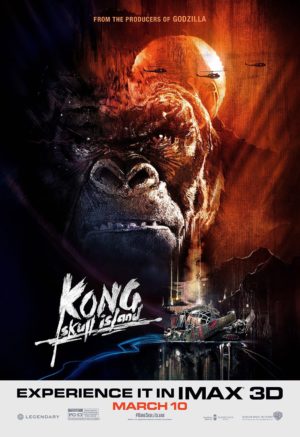 18. KONG: SKULL ISLAND
18. KONG: SKULL ISLAND
KING KONG meets APOCALYPSE NOW? I’m down for it, although this film didn’t quite live up to my expectations. It’s better than 2014’s GODZILLA, wasting little time on characterization (with the human protagonists, played by Tom Hiddleston, Samuel L. Jackson, Brie Larson and John C. Reilly being so bland they barely register) and keeping the emphasis where it belongs: on Kong and the many otherworldly creatures inhabiting his home turf of Skull Island during the Vietnam War. The show-offy camerawork and gratuitous slow-mo imparted by director Jordan Vogt-Roberts are a constant distraction, although this film’s most pressing problem in my view is that, simply, the King Kong on display here is TOO BIG! That may seem like a trifling concern but I say it’s a significant one, given that there’s little damage the human characters can hope to do to this monstrosity—and nor does it make much sense when Kong picks up and stares longingly at Brie Larson toward the end, as to him she’s the size of an insect. The final scenes, at least, which as in so many other modern blockbusters take place after the end credits, are intriguing, setting up a showdown between Kong and a certain other iconic movie monster that I, probably against my better judgement, am eager to see.
19. DOWNSIZING
Another case of wasted potential in a film with a riveting premise that’s squandered mightily. Matt Damon plays a disaffected suburbanite who agrees to be shrunk down to insect size and live in a specially designed miniature community in order to “help the environment.” This entails some fun sight gags and potent satiric commentary (such as the anti-miniature sentiments displayed by normal-sized folk), most of which is inexplicably jettisoned once Damon’s downsizing takes place. It appears that director/co-writer Alexander Payne grafted together two or more unrelated narratives, which would explain the disjointed and uncertain arc, which grows increasingly uninteresting, and concludes, obnoxiously enough, with one of Payne’s patented ambiguous fade-outs.
20. JUMANJI: WELCOME TO THE JUNGLE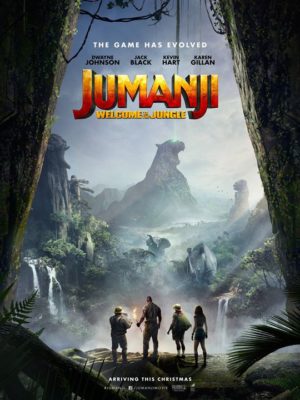
I’ll say this for JUMANJI: WELCOME TO THE JUNGLE: it’s better than the first JUMANJI. That film, released in 1995, was notable for some downright horrendous early-stage CGI. This sequel/reboot likewise contains a great deal of CGI in its story of four teens who travel into a jungle netherworld in which they become characters in a vast game, played by Dwayne Johnson, Kevin Hart, Jack Black and Karen Gillan. Director Jake Kasdan doesn’t evince much interest in the wraparound sequences with the teens, and the action-intensive jungle scenes are only so-so, with the funny lines by Kevin Hart and Jack Black (in a gender reversed role) being all that keeps the proceedings afloat.
21. WONDER
There’s a good movie lurking somewhere in WONDER, but it’s obscured by an excess of preachiness and sentimentality. Jacob Tremblay plays Auggie, a young boy with “facial differences” who suffers bullying because of that. We look in on his problems, and also those of his older sister (Izabela Vidovic), who feels left out of her family’s affections, as well as the latter’s estranged best friend (Danielle Rose Russell) and Auggie’s long-suffering mother (Julia Roberts), who’s put her ambitions on hold to take care of her children. All these conflicts are neatly and permanently solved, of course, in time for the overly saccharine conclusion. My recommendation? See MASK or the 1984 Russian drama SCARECROW for what WONDER could—nay, should—have been.
22. GERALD’S GAME
A well-intentioned film that had the cards stacked against it from the beginning. That beginning was Stephen King’s 1992 novel GERALD’S GAME, about a woman stuck handcuffed to a bed after an S&M session with her asshole hubbie goes horrifically wrong; yes, that about sums up the novel’s 332 agonizingly protracted pages. This film, directed by Mike Flanagan, sticks closely to King’s text, which explains why so much of it is so boring. To be sure, Carla Gugino is quite strong in the lead role, and Flanagan does his best to keep things lively with spectral appearances by Gugino’s dead hubbie (Bruce Greenwood), a fateful flashback to the Maine solar eclipse of 1963 (which was better utilized in King’s DOLORES CLAIBORNE novel and film), and a human flesh eating dog. Those things aren’t enough, alas, to jazz up material that only fitfully comes alive. Another problem is the addition of a creepy, and seemingly imaginary, personage who comes to dominate much of the film’s final third, but is too sketchily drawn to make a proper impression.
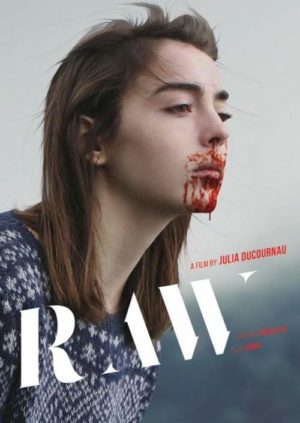 23. RAW
23. RAW
Lots of good things here, but bad storytelling does this film in. It’s a French made depiction of a young woman (Garance Marillier) whose family has raised her on a strict vegetarian diet, yet while attending an exclusive veterinary school she develops an insatiable hunger for meat—which, as any veteran horror movie viewer well knows, will surely lead to cannibalism. Had writer-director Julia Ducournau stuck to this plotline the film might have turned out better, but Ducournau continually dilutes the focus with subplots involving the brutal hazing rituals doled out by Marillier’s schoolmates, her own virginity (a subject that like so much else in this film is frequently brought up and then immediately forgotten) and the sibling rivalry with her sister (Ella Rumpf), who appears to harbor cannibalistic proclivities of her own. For good measure, Ducournau also includes a number of disquieting images—a guy getting his eyeball licked, a dog dissection, a close-up bikini waxing—that do nothing to help clarify matters. That’s despite an engaging turn by Marillier and a portrayal of campus life and its darker aspects that feels disturbingly authentic.
24. STAR WARS: THE LAST JEDI
A movie that confirms all the worst fears STAR WARS fans had about the Disney-fication of the franchise. THE LAST JEDI is the most overtly Hollywood of all the STAR WARS flicks, which has the effect of highlighting just how quirky the original trilogy was. Note the parade of recognizable actors (Laura Dern, Benicio del Toro, the kid from LOOPER) who turn up here, in defiance of George Lucas’s “no movie stars” decree, and also the overwrought sentimentality and cutesiness with which writer-director Rian Johnson slathers the proceedings, something Lucas (yes, even the Lucas of RETURN OF THE JEDI) would have never allowed. Another Hollyweird element Johnson includes is the overall structure, which appears to be a product of the James Cameron school of screenwriting—meaning there’s about ninety minutes of plot followed by an hour’s worth of lengthy and repetitive action sequences. Sure, the flick has a number of impressive elements, and Johnson evinces real ingenuity in his riffs on many shopworn sci fi conventions (the use of weaponized light speed was an especially neat touch), so taken as a standard sci fi-actioner THE LAST JEDI is indeed above average. As a STAR WARS movie, however, it falls short.
Still Waiting On…
ANNIHILATION
Writer-director Alex Garland’s adaptation of Jeff Vandermeer’s popular 2014 novel has been compared to 2001: A SPACE ODYSSEY (by Vandermeer himself), and I can’t say I’m not intrigued.
BASED ON A TRUE STORY
This Roman Polanski thriller is said to not be very good, but I’m always up for anything by Polanski. No, I wouldn’t want him babysitting my children, but that, people, is NOT the issue here!
CANIBA
An eccentric documentary about the infamous Japanese cannibal-murderer Issei Sagawa that, I understand, has already managed to seriously freak out audiences around the world.
DESPITE THE NIGHT (MALGRE LA NUIT)
The latest feature by France’s Philippe Grandrieux, of SOMBRE and UN LAC—which IMO should be recommendation enough!
FIRST REFORMED
Paul Schrader’s latest is said to be a provocative and disturbing look at faith and environmentalism.
THE HOUSE THAT JACK BUILT
A serial killer drama from Lars von Trier with Matt Dillon, Uma Thurman and Riley Keough. Von Trier, BTW, was one of the targets of the Me Too movement, meaning that—oops!—I’ve just brought up another controversial figure, one whose troubles might well impact this movie’s release.
THE IRISHMAN
Scorsese, De Niro, Pacino and Pesci? I wanna see it!
THE MAN WHO KILLED DON QUIXOTE
This is Terry Gilliam’s long in the works fantasy, an earlier, never-finished incarnation of which was the subject of the ‘02 documentary LOST IN LA MANCHA. The pic, it seems, is FINALLY complete, and ready for release!
MANDY
A new film by writer-director Panos Cosmatos that’s said to explore terrain similar to that of his dazzling 2010 debut BEYOND THE BLACK RAINBOW.
NICO, 1988
A biopic focusing on the last year in the life of the infamous avant-garde musician Christa Paffgen, a.k.a. Nico, that I understand contains plenty of drug-taking.
A QUIET PLACE
I don’t know much about this Emily Blunt starrer, but it looks plenty weird, as evinced by this plot summary on imdb.com.
